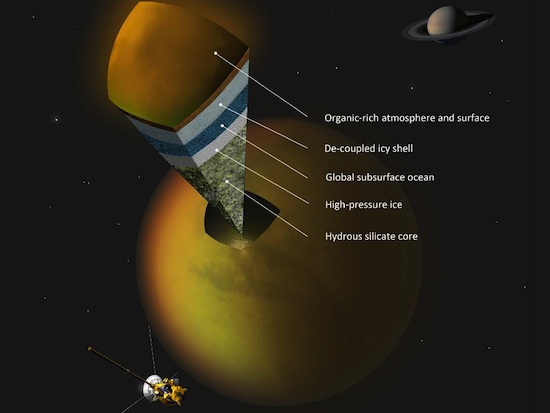Saturn’s moon Titan just keeps getting more and more interesting. A few weeks ago, we wrote about how NASA scientists discovered large methane lakes along the moon’s equator — exactly where our understanding of the moon says that they should not be. Now, new analysis of data from the Cassini probe suggests that there’s even more going on below the moon’s surface: A global ocean of liquid water.
While the news about a possible ocean beneath Titan’s surface is exciting, just as astonishing is how scientists deduced its existence. As Titan orbits Saturn, the gravity of the enormous planet exerts a great pull on the moon — so much so that Titan slightly changes shape as it moves toward and away from Saturn. This deformation of the moon would take the form of bulges or “tides” in the water-ice that makes up much of the surface of Titan.
If the moon was rocky to its core, NASA scientists anticipated bulges of around three feet. Though they did observe bulges, they were much, much larger — some thirty feet.
NASA’s press release quotes Luciano Iess, the lead author of a paper on Titan’s hidden ocean:
“Cassini’s detection of large tides on Titan leads to the almost inescapable conclusion that there is a hidden ocean at depth,” […] “The search for water is an important goal in solar system exploration, and now we’ve spotted another place where it is abundant.”
The team’s paper on the subject was printed in yesterday’s edition of the journal Science.
What’s most interesting about this discovery is how it might fit in with the aforementioned methane lakes. The problem with those lakes is that at Titan’s equator, methane should be evaporating so fast that it could never accumulate in large quantities. In fact, though methane is extremely plentiful on the planet, it should have run out. Until yesterday’s announcement, scientists assumed that the lakes were fed from underground aquifers of methane. This new evidence poses an alternative. Again, from NASA:
“The presence of a liquid water layer in Titan is important because we want to understand how methane is stored in Titan’s interior and how it may outgas to the surface,” said Jonathan Lunine, a Cassini team member at Cornell University. “This is important because everything that is unique about Titan derives from the presence of abundant methane, yet the methane in the atmosphere is unstable and will be destroyed on geologically short timescales.”
A liquid water ocean, “salted” with ammonia, could produce buoyant ammonia-water liquids that bubble up through the crust and liberate methane from the ice. Such an ocean could serve also as a deep reservoir for storing methane.
So while methane may make up most of Titan’s above ground activity, the moon’s methane cycle may be driven by underground oceans of water.
As far as the question of life on Titan, the water is intriguing, but doesn’t necessarily move the argument in either direction. Water, of course, is essential to life on Earth and is often thought of as a kind of benchmark for life on other worlds. However, NASA scientists believe that it’s more likely for life to exist where water meets rock. If, for instance, Titan’s underground ocean is sandwiched between layers of ice, then life seems less likely.
What is certain is that the complexities of Titan are only just being discovered. Scientists are finally beginning to understand the fundamental processes on the moon but it seems like Titan always has a little bit more to tell us. This is an exciting time.
 (via NASA, images via Cassini)
(via NASA, images via Cassini)
- Equatorial methane lakes on Titan surprise scientists
- Gorgeous photos of Saturn from Cassini
- Here’s a great pic of Titan and Dione
- More clues as to the composition of Titan








Published: Jun 29, 2012 05:10 pm